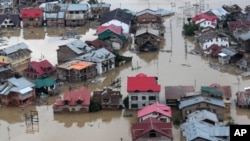A new report largely blames man-made factors for most disaster-related displacement. The Internal Displacement Monitoring Center of the Norwegian Refugee Council reports more than 19.3 million people in 100 countries were forced to flee their homes in 2014 because of natural disasters, such as floods, storms and earthquakes.
The Internal Displacement Monitoring Center report finds an average of 22.5 million people have been displaced by climate or weather-related disasters each year since 2008.
It says Asia, which is home to 60 percent of the world’s population, accounts for 87 percent of those displaced last year. It notes people in China, India and the Philippines were the most severely affected.
In 2014, the report says Europe experienced double its average level of displacement for the past seven years, while displacement in Africa was three times lower than the average. But relative to their population size the report says many African countries, such as Sudan, experienced high levels of disaster displacement.
Climate change
The report notes climate change is expected to increase the frequency and intensity of natural disasters. It says rapid economic development, urbanization and population growth in hazard prone areas are the man-made factors driving an overall trend in increasing disaster displacement.
Internal Displacement Monitoring Center Director Alfredo Zamudio says the likelihood of people becoming displaced by disaster today is 60 percent higher than four decades ago.
“Our report shows that how it is not the hazard itself that determines the devastation it causes," he said. "In fact, much of it is driven by man-made factors. Indeed most of the displacement is related to the impact of climate or weather hazards.”
Worsening expected
The International Organization for Migration assisted in data collection for the report.
IOM Director-General, William Lacy Swing tells VOA the impact on forced migration when climate change kicks in will exacerbate an already serious situation.
“There are more people in movement today than in any other time in recorded history, about one billion out of our seven billion in the world — a quarter of these crossing borders and three-quarters moving within their own country. Secondly, the percentage of these who are forced to migrate is also unprecedented,” he said.
Authors of the report say preventive measures, such as the construction of buildings that can withstand earthquakes or early warning systems to alert communities of the onset of storms or floods can reduce the risks from natural hazards and lighten their tragic after effects.







